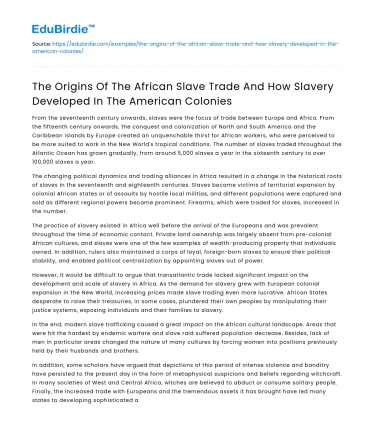From the seventeenth century onwards, slaves were the focus of trade between Europe and Africa. From the fifteenth century onwards, the conquest and colonization of North and South America and the Caribbean islands by Europe created an unquenchable thirst for African workers, who were perceived to be more suited to work in the New World's tropical conditions. The number of slaves traded throughout the Atlantic Ocean has grown gradually, from around 5,000 slaves a year in the sixteenth century to over 100,000 slaves a year.
The changing political dynamics and trading alliances in Africa resulted in a change in the historical roots of slaves in the seventeenth and eighteenth centuries. Slaves became victims of territorial expansion by colonial African states or of assaults by hostile local militias, and different populations were captured and sold as different regional powers became prominent. Firearms, which were traded for slaves, increased in the number.
Save your time!
We can take care of your essay
- Proper editing and formatting
- Free revision, title page, and bibliography
- Flexible prices and money-back guarantee
The practice of slavery existed in Africa well before the arrival of the Europeans and was prevalent throughout the time of economic contact. Private land ownership was largely absent from pre-colonial African cultures, and slaves were one of the few examples of wealth-producing property that individuals owned. In addition, rulers also maintained a corps of loyal, foreign-born slaves to ensure their political stability, and enabled political centralization by appointing slaves out of power.
However, it would be difficult to argue that transatlantic trade lacked significant impact on the development and scale of slavery in Africa. As the demand for slavery grew with European colonial expansion in the New World, increasing prices made slave trading even more lucrative. African States desperate to raise their treasuries, in some cases, plundered their own peoples by manipulating their justice systems, exposing individuals and their families to slavery.
In the end, modern slave trafficking caused a great impact on the African cultural landscape. Areas that were hit the hardest by endemic warfare and slave raid suffered population decrease. Besides, lack of men in particular areas changed the nature of many cultures by forcing women into positions previously held by their husbands and brothers.
In addition, some scholars have argued that depictions of this period of intense violence and banditry have persisted to the present day in the form of metaphysical suspicions and beliefs regarding witchcraft. In many societies of West and Central Africa, witches are believed to abduct or consume solitary people. Finally, the increased trade with Europeans and the tremendous assets it has brought have led many states to developing sophisticated artistic practices, using expenditure.






 Stuck on your essay?
Stuck on your essay?

